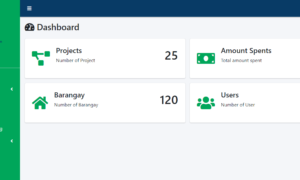Courseware on Computer Systems Servicing NCII
The main purpose of the study is to design, develop and implement a courseware in computer system servicing as an aide in teaching computer hardware and basic networking as an exploratory course for High School students and not treated as a replacement for teachers.
The potential benefits of this tool cannot be underestimated in the contemporary world. It is obvious that the current trend in search all over the world is the use of computer facilities and resource to enhance students learning. It is also further showed that the interactive approaches to lecturing significantly enhance learning with the use of technology. With this, the system also contains report modules which show the students’ performance from the start of the assessment.

Review of Related Literatures and Studies
This section contains the related literatures and studies on elearning/courseware for computer system servicing as the core component, related concepts, prior arts and synthesis.
Review of Related Literatures
Effects of Computer-Assisted-Instruction on Different Learners
According to Tray Nor, Patrick L.2010, the purpose of this study was to determine how computer-assisted-instruction improves student performance among various types of students. 161 middle school students of various program types: special education, non-English proficient, limited English proficient and regular education, completed instructional units using a computer program, Corner Stone.
There is no doubt that technology has become incorporated into our school systems. Computers are used not only as a means of helping schools analyze data, computers have become a pervasive tool toward optimizing student learning. For example, students are regularly using the Internet to gather and assimilate information for use in research assignments. They are preparing “electronic” presentations using computer presentation programs and LCD projectors. They are using word processing programs to create various other reports. Students are even using spreadsheets to increase their experiences with mathematical concepts. In addition, many schools have incorporated interactive computer-assisted-instruction into their program to provide students opportunities to master specific educational objectives or standards.
The animation of objects involved in the explanation of a particular concept, for example, Newton’s First Law of Motion, increases learning by decreasing the cognitive load on the learner’s memory thereby allowing the learner to perform search and recognition processes and to make more informational relationships. (Academic journal article from Journal of Instructional Psychology, Vol. 30, No. 2)
The Influence of Computer-Assisted Instruction on Eighth Grade Mathematics Achievement
In the study of Tienken, Christopher H.; Maher, James A., the issue of lower than expected mathematics achievement is a concern to education leaders and policymakers at all levels of the U.S. PK-12 education system. In two categories, students who received the CAI performed significantly lower than their peers in the comparison group. Students in the control group who scored in the 25th percentile on the seventh grade CTB/McGraw Hill TerraNova pretest outperformed their peers in the treatment group on the New Jersey Grade Eight Proficiency Assessment (GEPA) mathematics section. Likewise, Asian students in the control group outperformed all other students in treatment and control groups. The results fit within the existing knowledge on the subject of computer-assisted instruction and add support to the idea that practitioners should evaluate curriculum and instruction interventions for demonstrated success before they bring them into the learning environment.
The issue of lower than expected mathematics achievement is a persistent worry to some education leaders and policymakers at all levels of the U.S. PK- 12 education system. These achievement statistics raise concerns for some education leaders and policymakers about the mathematics achievement of U.S. middle school students.
The expanding scourge of childhood poverty across the nation, and the corresponding negative influence on achievement, requires education leaders to use interventions with demonstrated records of success. (Academic journal article from RMLE Online, Vol. 32, No. 3
Behavioral Improvements Associated with Computer-Assisted Instruction for Children with Developmental Disabilities
According to the study of Whalen, Christina; Liden, Lars; Ingersoll, Brooke; Dallaire, Eric;2008 Liden, Sven, the TeachTown is a new computer-assisted instruction (CAI) program that utilizes best-practices ABA to teach a variety of skills to young children. Study 1 investigated the effect of the software on the acquisition of receptive language, cognitive, and social skills by 4 children with autism and 4 children with other developmental delays using a pre-test/post-test design. Social validity with parents, teachers, and clinicians was also assessed. Study 2 used a multiple-baseline design across the 4 children with autism to investigate whether CAI impeded the children’s spontaneous use of language and social behaviors. Results suggested that the computer-assisted instruction actually enhanced social-communication and decreased inappropriate behaviors. Results are discussed in terms of the potential of using CAI programs for children with autism.
Keywords: Computer, Autism, Social-Communication, Language, Discrete Trial Training, Pivotal Response Training
Children with autism and other developmental disorders exhibit significant difficulties learning through traditional teaching methods. One method that has had substantial effectiveness in the education of these young children is applied behavior analysis (ABA). ABA encompasses a variety of teaching strategies which are drawn from the learning literature and includes both highly-structured and more naturalistic teaching approaches. Most ABA teaching techniques involve intensive, one-to-one instruction. Although ABA has been shown to be extremely effective for teaching new skills to young children with autism, it is often prohibitively expensive due to the significant amount of teacher time and materials need to implement it effectively.
With recent advances in computer technology, there has been a strong interest in the use of computer-assisted instruction (CAI) in the education of children with disabilities. There are several reasons to be excited about the possibility of using computers to implement ABA interventions with young children with autism. First, using computers may help to reduce the number of staff and staff training saving families and school districts substantial amounts of money. Second, it can be implemented with a high degree of fidelity. ABA instruction requires significant staff training to be implemented effectively. A computer program which uses ABA principles can be designed to always provide appropriate prompts and reinforcement consistently. Third, programs that automatically collect data on the child’s performance may provide more accuracy and more comprehensive data than personal instruction. Fourth, computer instruction may be implemented by untrained providers, increasing the number of hours of intervention. Fifth, it is highly motivating for many children as has been demonstrated by the very profitable computer game industry for young children. If computers are more motivating for children with autism and they are able to attend longer, many skills can be taught with reduced behavior problems and increased learning time. Finally, because computers can store great amounts of information, more exemplars of concepts can be presented which will reduce the cost of materials for treatment and potentially increase generalization.( Academic journal article from The Journal of Speech-Language Pathology and Applied Behavior Analysis, Vol. 1, No. 1)
Review of Related Studies
Effects of Supplemental Computer-Assisted Reciprocal Peer Tutoring on Kindergarteners’ Phoneme Segmentation Fluency
In the study of Wood, Charles L.; Mustian, April L.; Lo, Ya-yu, 2009, phonemic awareness is a critical early reading skill that gives students a strong foundation for beginning reading. Without effective interventions or supplements to core reading programs, many students fail to acquire these skills. The present study examined the effects of using computer-assisted peer tutoring to supplement kindergarten students’ instruction in phonemic awareness. Results of the study indicate three of the four participants made substantial gains in phoneme segmentation fluency. Implications for future research and practice are discussed.
Reading is a fundamental skill that influences almost every other area of learning. When children become efficient readers early, they are much more likely to experience better educational outcomes throughout their school years (Armbruster, Lehr, & Osborn, 2001; Bursuck & Damer, 2011). Unfortunately, millions of children in the United States are left behind due to early reading failure; and for whom, the adverse effects can last a lifetime. For these children, early identification and effective interventions in reading become critical in setting the precedent for successful outcomes.
In order to pinpoint key skills and effective methods central to reading achievement, the National Reading Panel (National Institute of Child Health and Human Development [NICHHD],) examined over 100,000 studies on reading components and interventions and identified five essential areas of reading instruction for all children. The five areas were phonemic awareness, phonics, fluency, vocabulary, and text comprehension. Within these five areas, phonemic awareness is considered a foundational skill. Bursuck and Darner (2011) define phonemic awareness as “the ability to hear and manipulate the smallest units of sound in spoken language. Competency in phonemic awareness improves a child’s ability to read and spell; whereas deficits in phonemic awareness can impact overall reading achievement. Effective phonemic awareness instruction that focuses on having children think about and manipulate individual sounds in spoken language is indisputably important and should be a part of the core reading program.(Academic journal article from Education & Treatment of Children, Vol. 36, No. 1)
Effectiveness of Using Computer-Assisted Supplementary Instruction for Teaching Selected Algebra Topics at a Laboratory High School
Bassoppo-Moyo, Temba C. 2008, stated that Mathematics educators have recognized that algebra is the main tool for working with several mathematical systems. The algebraic knowledge and skills are also necessary for solving problems in scientific and non-scientific disciplines. Educators and policy makers alike recognize that algebra is an important gatekeeper course, not only for college preparation but also for preparation for the world of work. This makes the understanding of central concepts of algebra of paramount importance to high school students intending a wide variety of careers. To prepare students for future success, many school districts and state legislatures now make algebra a graduation requirement for all high school students.
Several factors have been attributed to students’ difficulties with algebra such as: mathematics anxiety (Hembree, 2008), personality traits (Brody & Stephens, 2010), lack of resources, poor mathematical background, students’ negative attitudes towards mathematics, and lack of good teaching approaches. Other studies have established that the difficulties that the high school students experience are mainly the result of deficiencies in their abstract thinking and formal reasoning abilities (Rech, Juhler, & Johnson, 2009). Abstractness of knowledge is thought to have an influence on learning difficult mathematics concepts such as those in algebra. Specifically, in solving problems that involve algebra students have to deal with several expressions (Brody & Rosenfield, 2008).
Recent studies suggest that the problem is not entirely due to these factors. Rather the difficulties that the high students experience could also be due to lack of supplementary instruction. This problem could be worse for average students enrolled in mathematics courses. Such students would need supplementary instruction if they are to develop sound algebraic knowledge and skills. Research has shown that supplementary instruction has an effect on students’ achievement and their attitude towards mathematics (Morrell, 2008). Therefore, there is need to provide supplementary instruction to average students as a way of helping them develop sound understanding of the unusually abstract algebra concepts. In addition, students should also be exposed to several ways of solving algebra problems through supplementary instruction delivered via different media. Recent studies strongly support the use of Computer-Assisted Instruction (CAI) as effective in teaching mathematics (Bennet, 2008; Mayes, 2008). In addition, the National Council of Teachers of Mathematics (1989) has vigorously supported the appropriate use of computers and other technology as a means for students to explore mathematics content and to focus on problem solving. In this article CAI is described as the teaching and learning process where the computers are used to deliver the instruction. CAI may be designed to introduce new materials, allow practice of new skills, and provide review and remediation when necessary. If properly used CAI, has the potential to provide a great variety of algebra problems, and ways of solving those problems (Damarin, Dziak, Stull, & Whiteman, 2010). (Academic journal article from International Journal of Instructional Media, Vol. 37, No. 1)
The Effect on Retention of Computer Assisted Instruction in Science Education
In reference to the study of Kara, Izzet, 2012 the aim of this research is to determine the retention effect of Computer Assisted Instruction (CAI) on students’ academic achievement for teaching the Physics topics. The research includes the Force and Pressure units of 7th grade Science Lesson. In this research, 132 students were structured as both control and experiment groups. Traditional instruction (TI) method is used for control group while traditional instruction with teacher supervised CAI method is used for experiment group. Scientific subject test was applied as pre-test and post-test to both groups. 5 months later, the Science Subject test was applied to both groups again. Significant differences between the Science Subject test scores of experiment and control group were found in favor of experiment group.
Instruction materials are among the assistant materials which teachers use them to make instruction more effective, lasting and enjoyable. Computers that are used as both a material and method and instructional materials are effective for making students concentrate on, understanding of, synthesizing and improving positive attitude towards the subject of the course. Therefore, the usage of visual instructional materials is so much important in the instruction of abstract concepts as being included in Science Lesson, understanding of the subject by students and improving positive attitude towards the course.
Nowadays, it is obvious that visual materials have been used in every field and technological devices, especially televisions and computers, have affected students. There are experimental evidences that only oral explanation method doesn’t work well. If principles of how students learn are taken into account, richness of the visual content makes instruction more lasting and effective.
For these reasons, we have to develop scientific lessons as the ones that are supported by visual and audio instructional materials to draw students’ attention and so provide lasting learning, reflect science nature and accelerate learning. Therefore, provisions of educational and instructional materials having more visual content are necessary in order to teach to the person of this time. (Academic journal article from Journal of Instructional Psychology, Vol. 35, No. 4)
You may visit our Facebook page for more information, inquiries, and comments. Please subscribe also to our YouTube Channel to receive free capstone projects resources and computer programming tutorials.
Hire our team to do the project.


